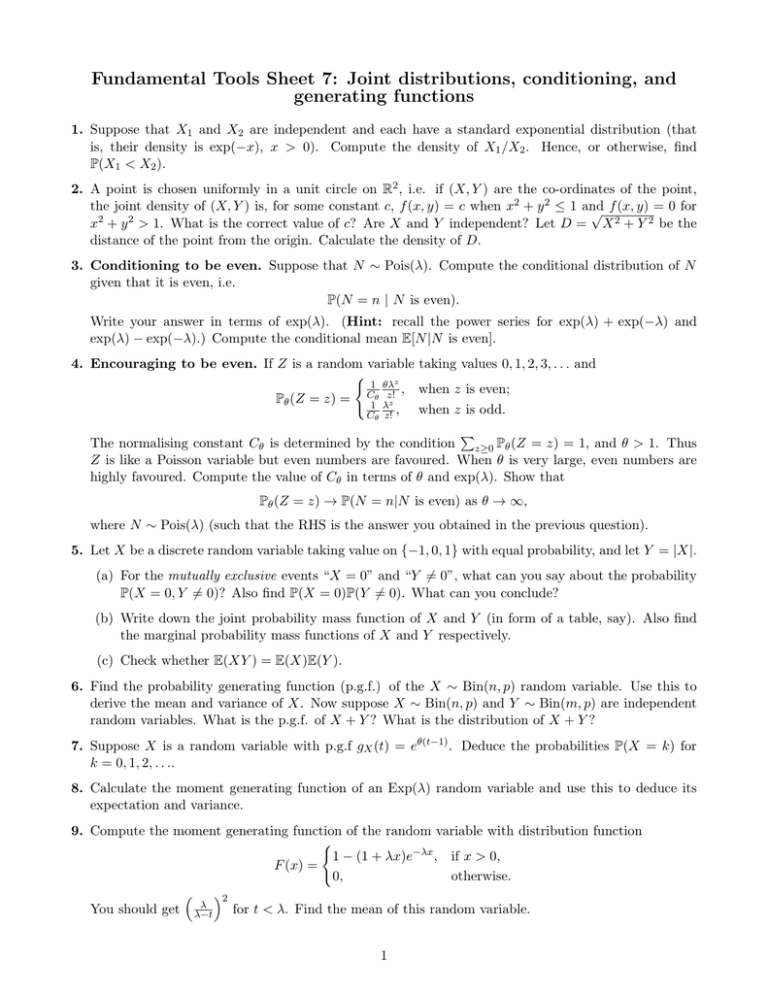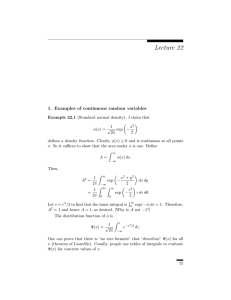Fundamental Tools Sheet 7: Joint distributions, conditioning, and generating functions
advertisement

Fundamental Tools Sheet 7: Joint distributions, conditioning, and
generating functions
1. Suppose that X1 and X2 are independent and each have a standard exponential distribution (that
is, their density is exp(−x), x > 0). Compute the density of X1 /X2 . Hence, or otherwise, find
P(X1 < X2 ).
2. A point is chosen uniformly in a unit circle on R2 , i.e. if (X, Y ) are the co-ordinates of the point,
the joint density of (X, Y ) is, for some constant c, f (x, y) = c when x2 + y 2 ≤ 1 and
√ f (x, y) = 0 for
2
2
x + y > 1. What is the correct value of c? Are X and Y independent? Let D = X 2 + Y 2 be the
distance of the point from the origin. Calculate the density of D.
3. Conditioning to be even. Suppose that N ∼ Pois(λ). Compute the conditional distribution of N
given that it is even, i.e.
P(N = n | N is even).
Write your answer in terms of exp(λ). (Hint: recall the power series for exp(λ) + exp(−λ) and
exp(λ) − exp(−λ).) Compute the conditional mean E[N |N is even].
4. Encouraging to be even. If Z is a random variable taking values 0, 1, 2, 3, . . . and
(
1 θλz
Cθ z! , when z is even;
Pθ (Z = z) = 1 λz
when z is odd.
Cθ z! ,
P
The normalising constant Cθ is determined by the condition z≥0 Pθ (Z = z) = 1, and θ > 1. Thus
Z is like a Poisson variable but even numbers are favoured. When θ is very large, even numbers are
highly favoured. Compute the value of Cθ in terms of θ and exp(λ). Show that
Pθ (Z = z) → P(N = n|N is even) as θ → ∞,
where N ∼ Pois(λ) (such that the RHS is the answer you obtained in the previous question).
5. Let X be a discrete random variable taking value on {−1, 0, 1} with equal probability, and let Y = |X|.
(a) For the mutually exclusive events “X = 0” and “Y 6= 0”, what can you say about the probability
P(X = 0, Y 6= 0)? Also find P(X = 0)P(Y 6= 0). What can you conclude?
(b) Write down the joint probability mass function of X and Y (in form of a table, say). Also find
the marginal probability mass functions of X and Y respectively.
(c) Check whether E(XY ) = E(X)E(Y ).
6. Find the probability generating function (p.g.f.) of the X ∼ Bin(n, p) random variable. Use this to
derive the mean and variance of X. Now suppose X ∼ Bin(n, p) and Y ∼ Bin(m, p) are independent
random variables. What is the p.g.f. of X + Y ? What is the distribution of X + Y ?
7. Suppose X is a random variable with p.g.f gX (t) = eθ(t−1) . Deduce the probabilities P(X = k) for
k = 0, 1, 2, . . ..
8. Calculate the moment generating function of an Exp(λ) random variable and use this to deduce its
expectation and variance.
9. Compute the moment generating function of the random variable with distribution function
(
1 − (1 + λx)e−λx , if x > 0,
F (x) =
0,
otherwise.
2
λ
You should get λ−t
for t < λ. Find the mean of this random variable.
1





